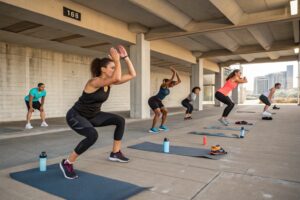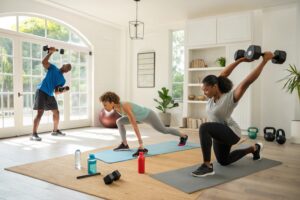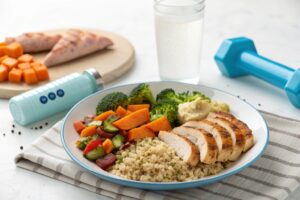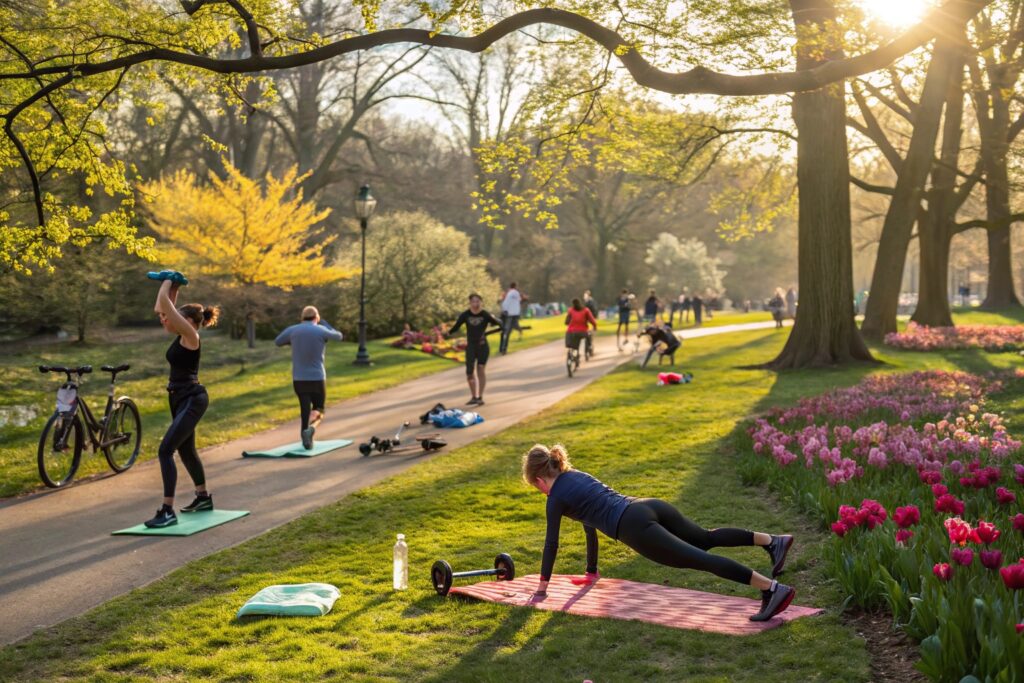[Introduction]
Spring is the perfect time to shake off the extra layers gained during the colder months and Spring into Fitness: The Best Workouts for Shedding Winter Weight and Getting Ready for Summer. As daylight hours lengthen and temperatures rise, your body naturally craves movement. This guide walks you through scientifically‑backed workouts, nutrition tips, and recovery strategies that will transform winter inertia into summer‑ready confidence.
Whether you’re a busy professional, a stay‑at‑home parent, or a college student, this roadmap offers adaptable routines that fit any schedule. From high‑intensity interval training (HIIT) to low‑impact mobility work, each section is engineered to accelerate fat loss, preserve lean muscle, and boost overall energy—setting the stage for a vibrant, healthy summer.
Why Spring is the Optimal Time for Fat Loss (Great Keyword)
Natural Hormonal Shifts That Favor Weight Loss
When the days get longer, your body produces more melatonin‑suppressing light exposure, which in turn boosts serotonin and cortisol rhythms that favor a higher basal metabolic rate. Studies show that a 2‑hour increase in daylight can raise daily calorie expenditure by up to 150 calories without any additional activity.
Seasonal Food Availability Encourages Healthier Choices
Fresh, locally‑grown produce—think asparagus, strawberries, and leafy greens—flourishes in spring. These foods are low in calories but high in fiber, vitamins, and antioxidants, helping you stay full longer while supporting detoxification pathways that break down stored fat.
Beyond biology, spring offers practical benefits: open parks, community fitness events, and an enthusiastic social vibe that keeps motivation high. Leveraging these seasonal advantages maximizes the effectiveness of any workout program you choose.
High‑Intensity Interval Training: Torch Calories Fast (Great Keyword)

What Makes HIIT a Fat‑Burning Powerhouse?
HIIT alternates short bursts of maximal effort with brief recovery periods, creating an “afterburn” effect known as excess post‑exercise oxygen consumption (EPOC). This means you continue burning calories long after the workout ends—sometimes up to 48 hours.
Sample 20‑Minute HIIT Routine for Spring
Warm‑up (3 minutes): Light jog or dynamic stretches.
Round 1 (30 seconds each, 90‑second rest): Jump squats → Push‑up‑to‑row (with dumbbells) → Mountain climbers → Burpees.
Round 2 (30 seconds each, 60‑second rest): High knees → Plank shoulder taps → Alternating lunge jumps → Fast feet shuffle.
Cool‑down (3 minutes): Gentle walking + static stretching for hamstrings, chest, and hips.
Adjusting HIIT for Different Fitness Levels
Beginners can start with a 10‑minute session, using a 20‑second work/40‑second rest ratio. Advanced athletes can push to 45‑second bursts with only 15‑second recovery, or add resistance bands for extra load. Consistency—3‑4 sessions per week—is more important than intensity.
Outdoor Cardio for Spring: Running, Cycling & Hiking (Great Keyword)
Running: The Classic Fat‑Loss Tool
Running remains one of the most efficient ways to burn calories. A moderate‑pace 30‑minute run can expend 300‑400 calories, while interval sprints can double that number. For spring, aim for “run‑walk‑run” strategies if you’re returning after a winter hiatus—alternate 2 minutes of jogging with 1 minute of brisk walking.
Cycling: Low‑Impact, High‑Reward
Whether on a road bike, mountain bike, or stationary trainer, cycling spares joints while delivering a high calorie burn. Incorporate hill repeats or resistance spikes every 5 minutes to keep the heart rate in the fat‑burn zone (70‑80% of max HR). A 45‑minute ride can burn 500‑600 calories.
Hiking: Combining Cardio with Strength
Spring trails offer varying elevations that naturally blend cardio with lower‑body strength work. Pack a lightweight backpack (5‑10 lbs) to intensify the effort. A 2‑hour hike can burn 800‑1000 calories, especially when navigating steep ascents.
Tip: Schedule outdoor cardio early in the day to avoid peak UV exposure and to take advantage of cooler morning temperatures, which helps maintain performance and prevents dehydration.
Strength Training: Build Lean Muscle & Boost Metabolism (Great Keyword)

Why Strength Is Essential for Weight Loss
Muscle tissue is metabolically active—each pound of muscle can burn 6‑10 calories at rest compared to 2‑3 calories for fat. Incorporating resistance training 2‑3 times weekly accelerates the transition from winter “couch‑muscle” to summer “lean‑muscle”.
Full‑Body Spring Strength Circuit
Goblet Squat (12 reps) – Targets quads, glutes, and core.
Push‑Up (10‑15 reps) – Works chest, shoulders, triceps.
Dumbbell Deadlift (12 reps) – Engages posterior chain.
Bent‑Over Row (12 reps) – Strengthens back and biceps.
Plank with Shoulder Tap (30 seconds) – Core stability.
Rest 60 seconds, repeat 3‑4 rounds.
Progression Strategies
Increase weight by 5‑10% once you can complete 4 full rounds with perfect form. Alternatively, add supersets (pair two exercises back‑to‑back) or reduce rest intervals to heighten intensity. Don’t forget to incorporate unilateral moves (single‑leg deadlifts, single‑arm presses) to improve balance and address muscular asymmetries.
Flexibility, Recovery & Nutrition to Maximize Spring Results (Great Keyword)
Dynamic Stretching Before Workouts
Dynamic movements—leg swings, arm circles, walking lunges—prepare joints for activity, improve range of motion, and reduce injury risk. Spend 5‑7 minutes on a dynamic routine that mirrors the muscle groups you’ll be training that day.
Static Stretching & Mobility After Workouts
Post‑exercise static holds (30‑45 seconds per stretch) aid in muscle lengthening, alleviate soreness, and promote circulation. Incorporate yoga poses such as Downward Dog, Pigeon, and Child’s Pose to target hips, hamstrings, and lower back—areas commonly tight after running or cycling.
Spring Nutrition Blueprint: Fuel the Fat‑Loss Engine
-
- Protein: Aim for 1.2‑1.6 g per kilogram of body weight daily. Sources include eggs, Greek yogurt, lean poultry, tofu, and legumes.
-
- Complex Carbohydrates: Choose whole grains (quinoa, barley), starchy vegetables (sweet potatoes) and seasonal fruit to maintain glycogen stores for high‑intensity sessions.
-
- Healthy Fats: Avocado, nuts, seeds, and olive oil support hormone balance, especially estrogen and testosterone, which are vital for muscle preservation.
-
- Hydration: Spring weather can still be deceptively dehydrating. Aim for 2‑3 L of water daily; add electrolytes if you sweat heavily during outdoor cardio.
Meal Timing & Portion Control

Consume a balanced post‑workout meal within 45 minutes—protein + carbs (e.g., grilled chicken + quinoa + mixed greens). This refuels muscles and spikes insulin modestly, encouraging nutrient uptake without excessive fat storage. For weight loss, maintain a modest calorie deficit of 250‑500 kcal per day; this ensures steady fat loss while preserving lean mass.
Finally, listen to your body. If you feel persistent fatigue, scale back intensity or add an extra rest day. Consistency, not perfection, determines long‑term success.
Conclusion: Your Personalized Spring Into Fitness Blueprint
By blending HIIT, outdoor cardio, strength circuits, and strategic nutrition, you create a holistic plan that melts winter weight while sculpting a summer‑ready physique. Commit to 3‑5 weekly sessions, honor recovery, and fuel with fresh spring produce—the results will be evident not just on the scale, but in your energy, confidence, and overall health.
Ready to jump in? Pick the first workout from the HIIT section, stock your kitchen with protein‑rich foods, and schedule your next outdoor run. Spring is here; it’s time to turn the season’s fresh promise into tangible, lasting fitness gains.



